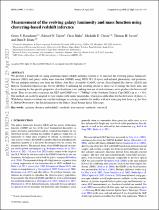| dc.contributor.author | Cluver, Michelle E | |
| dc.contributor.author | Karademir, Geray S | |
| dc.contributor.author | Blake, Chris | |
| dc.contributor.author | Taylor, Edward N | |
| dc.contributor.author | Jarrett, Thomas H | |
| dc.contributor.author | Triani, Dian P | |
| dc.date.accessioned | 2023-06-07T12:38:54Z | |
| dc.date.available | 2023-06-07T12:38:54Z | |
| dc.date.issued | 2023 | |
| dc.identifier.citation | Karademir, G.S., Taylor, E.N., Blake, C., Cluver, M.E., Jarrett, T.H. and Triani, D.P., 2023. Measurement of the evolving galaxy luminosity and mass function using clustering-based redshift inference. Monthly Notices of the Royal Astronomical Society, 522(3), pp.3693-3709. | en_US |
| dc.identifier.uri | https://doi.org/10.1093/mnras/stad1250 | |
| dc.identifier.uri | http://hdl.handle.net/10566/9066 | |
| dc.description.abstract | We develop a framework for using clustering-based redshift inference (cluster-z ) to measure the evolving galaxy luminosity function (GLF) and galaxy stellar mass function (GSMF) using Wide-field Infrared Survey Explorer W1 (3.4 μm) mid-infrared photometry and positions. We use multiple reference sets from the Galaxy And Mass Assembly survey, Sloan Digital Sky Survey and Baryon Oscillation Spectroscopic Survey. Combining the resulting cluster-z s allows us to enlarge the study area, and by accounting for the specific properties of each reference set, making best use of each reference set to produce the best overall result. | en_US |
| dc.language.iso | en | en_US |
| dc.publisher | Monthly Notices of the Royal Astronomical Society | en_US |
| dc.subject | Galaxies: distance | en_US |
| dc.subject | Methods: data analysis | en_US |
| dc.subject | Methods: statistical | en_US |
| dc.subject | Redshifts | en_US |
| dc.subject | Galaxy luminosity function (GLF) | en_US |
| dc.title | Measurement of the evolving galaxy luminosity and mass function using clustering-based redshift inference | en_US |
| dc.type | Article | en_US |

